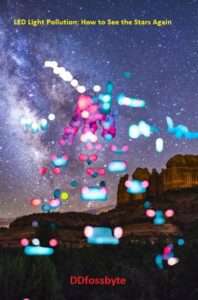In the age of technological advancements, the transition to LED lights has brought about significant changes in our daily lives. While these lights are energy-efficient and cost-effective, there’s a hidden cost that often goes unnoticed – light pollution. This article delves into the growing concern of light pollution and its impact on our ability to admire the night sky. We’ll explore how LED lights are contributing to this issue and why it’s a problem that’s worsening over time.

Light pollution is a growing problem that is making it harder to see the stars. LED lights, which are becoming increasingly common, are a major contributor to light pollution.
Understanding Light Pollution
- What is Light Pollution?
Light pollution refers to the excessive or misdirected artificial light produced by various sources, including streetlights, buildings, and outdoor advertising. This excess light scatters in the atmosphere, creating a luminous haze that obscures the natural darkness of the night sky.
- Types of Light Pollution
Light pollution comes in several forms, including skyglow, which brightens the night sky, making it difficult to see stars; glare, which causes visual discomfort; and light trespass, which occurs when unwanted light spills into areas where it’s not needed.
The Impact of LED Lights
- LED Lights and Skyglow
One of the primary contributors to light pollution is the widespread adoption of LED lighting. LED lights emit a cool, bluish-white light that scatters more easily in the atmosphere, increasing skyglow. This phenomenon is particularly concerning for astronomers and stargazers who rely on clear, dark skies to observe celestial objects.
- The Color Temperature Factor
The color temperature of LED lights, measured in Kelvin (K), plays a crucial role in their impact on light pollution. Higher Kelvin values result in cooler, bluish-white light, while lower values produce warmer, yellowish light. Many LED streetlights have high Kelvin ratings, exacerbating skyglow and making stars less visible.
The Consequences
- Effects on Astronomy
Astronomy enthusiasts are facing a constant struggle to view celestial objects due to light pollution. Dimmer stars, galaxies, and nebulae are often drowned out by the artificial glow, limiting our ability to explore the cosmos.
- Ecological Disruption
Light pollution also disrupts ecosystems and wildlife. Many species of birds, insects, and sea turtles rely on natural darkness for navigation and reproduction. Artificial light can confuse these creatures, leading to population declines and habitat disruptions.
The Worsening Problem
- Rapid Urbanization
As cities expand and urban areas grow, the demand for lighting increases. LED lights, with their energy efficiency and durability, have become the go-to choice for urban lighting projects, contributing to the worsening problem of light pollution.
- Lack of Regulation
In many regions, there is a lack of comprehensive regulations regarding outdoor lighting. This has allowed the uncontrolled proliferation of LED lights, further exacerbating the issue.

LED lights are brighter and more efficient than traditional light bulbs, but they also scatter more light. This means that more light is wasted, and more light is directed up into the sky, where it obscures the stars.
There are a number of things that can be done to reduce light pollution. One is to use more efficient light bulbs, such as LEDs. Another is to direct light downwards, where it is needed. And finally, communities can adopt dark sky friendly lighting ordinances.
If you are concerned about light pollution, there are a few things you can do to help. You can:
- Turn off unnecessary lights.
- Use dimmer bulbs.
- Direct light downwards.
- Support dark sky friendly lighting ordinances.
By taking these steps, we can help to protect the night sky and preserve our view of the stars.

The growing use of LED lights has brought about numerous benefits, but it has also inadvertently led to a rise in light pollution. This problem not only affects our ability to admire the stars but also has far-reaching ecological consequences. It’s imperative that we take steps to address light pollution and promote responsible lighting practices.
